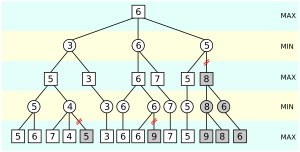Alpha-beta pruning facts for kids
Alpha-beta pruning is a clever way computers use to play two-player games like chess, go, and checkers. It's a type of Search algorithm that helps the computer decide the best move by ignoring options that are clearly not good. Imagine you're looking for the best path in a maze; this algorithm helps you quickly rule out dead ends without exploring them all the way. It's a faster version of another strategy called the Minimax algorithm.
Contents
How Computers Pick the Best Move
When a computer plays a game, it often looks ahead at many possible moves, like building a tree of choices. Alpha-beta pruning helps it do this more efficiently. It keeps track of two important numbers:
- Alpha (α): This is the best score the computer (your player) has found so far for itself. It's like saying, "I know I can at least get this score."
- Beta (β): This is the best score the opponent has found so far for themselves. It's like saying, "My opponent can at least get this score, which means I might get this score or worse."
The computer starts by assuming the best score for itself is very low, and the best score for the opponent is very high. As it looks at different moves, it updates Alpha and Beta.
Smart Shortcuts in Game Play
The magic of Alpha-beta pruning happens when the computer realizes a move is bad without having to check every single possibility.
- If the computer finds a move that is already better than what the opponent could possibly achieve (meaning Alpha becomes greater than or equal to Beta), it stops looking at that branch of moves. It knows the opponent would never let it get to that bad outcome anyway.
- It's like playing a game and realizing your opponent has a winning move, so you don't bother checking all your own bad moves. You just move on to find a better strategy.
This smart shortcut saves a lot of time and computing power, allowing the computer to think deeper into the game or make decisions faster.
How Fast Does it Work?
Alpha-beta pruning is much faster than checking every single possible move. Imagine a game where each move opens up many new choices (this is called the "branching factor"). Also, imagine how many moves deep the computer looks into the game (this is called the "depth").
- In the best situations, this algorithm can find the best move much quicker, almost like taking a shortcut through the game's possibilities.
- In the worst situations, it still works, but it might have to check more moves.
This algorithm is a key part of how computers can play complex games like chess so well, often beating human champions!
Images for kids
See also
 In Spanish: Poda alfa-beta para niños
In Spanish: Poda alfa-beta para niños



